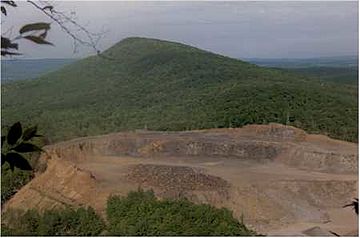Round Mountain (Massachusetts) facts for kids
Quick facts for kids Round Mountain |
|
|---|---|

Removal of Round Mountain by quarrying. 1989 photo; significantly more rock has since been removed.
|
|
| Highest point | |
| Elevation | 780 feet (238 m) (approximate) |
| Geography | |
| Location | Granby, Amherst, and South Hadley, Massachusetts. |
| Parent range | Holyoke Range / Metacomet Ridge |
| Geology | |
| Age of rock | 200 Ma |
| Mountain type | Fault-block; igneous |
| Climbing | |
| Easiest route | Metacomet-Monadnock Trail |
Round Mountain was once a peak in the Holyoke Range of mountains in Massachusetts. It stood about 780 feet (238 meters) above sea level. This mountain was part of a larger chain called the Metacomet Ridge, which stretches for a long way across the region. Round Mountain was mostly located in Granby, but parts of it were also in Amherst and South Hadley, Massachusetts.
Contents
What Happened to Round Mountain?
For many years, a company has been removing parts of Round Mountain. This process is called quarrying, and it started way back in 1897. Over time, most of the mountain has been taken away.
Before the quarrying, Round Mountain and a nearby peak called Bare Mountain formed a special area known as "the Notch." This was a narrow pass where Route 116 now runs. Travelers could see tall mountains on both sides of the road, making it feel like they were passing through a natural gateway.
The Changing Notch
Today, the Notch looks very different. The quarrying has leveled the land where Round Mountain once stood. Now, when you drive through, you only see a mountain on one side.
Long ago, before the modern highway, a trolley used to run through the Notch. The slopes of both mountains came right down to the trolley tracks, making the "notch" effect even more dramatic. You can still see the old path of this trolley line east of the current highway. Even before the trolley, it was a dirt road, and even further back, it was a path used by Native Americans.
How the Mountain Formed
Round Mountain, like many mountains in the Metacomet Ridge, was made of a type of rock called basalt. Basalt is a volcanic rock, meaning it formed from lava.
A Look at the Earth's Past
About 200 million years ago, during the late Triassic Period, the supercontinent Pangaea began to break apart. North America started to separate from Africa and Eurasia. As the land pulled apart, hot lava from deep inside the Earth pushed up to the surface. This lava spread out and cooled, forming thick layers of rock.
Over millions of years, the Earth's movements, like faulting and earthquakes, tilted these rock layers. This tilting created the steep cliffs and ridges that were once a part of Round Mountain.
Life on the Mountain
The unique geology of Round Mountain created different environments for plants and animals. The mountain had hot, dry upper slopes and cooler, moist areas in its ravines. The basalt rock also broke down into talus (loose rocks) that were rich in minerals.
These different conditions created a mix of tiny ecosystems, called microclimates. These microclimates supported many plant and animal species that are not common in other parts of Massachusetts. To learn more about the geology and ecosystems of these mountains, you can look up information about the Metacomet Ridge.

